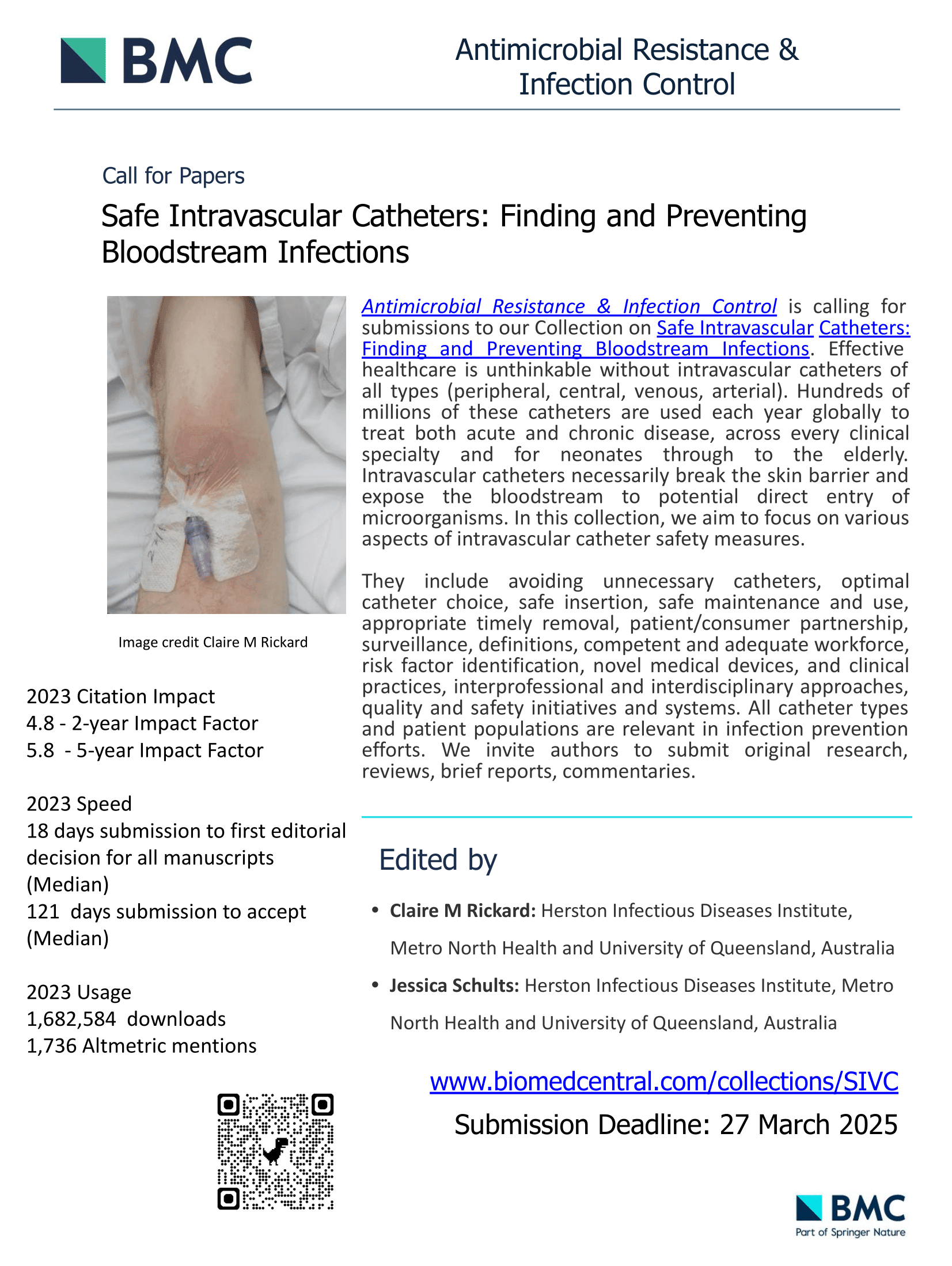Evaluating the Use of Peripherally Inserted Central Catheters in Pediatrics: Findings from a Multisite Study
Posted
on 20 August 2024
Introduction:
Peripherally inserted central catheters (PICCs) are vital for administering long-term intravenous therapies in pediatric patients. However, their use must align with guidelines to ensure safety and efficacy. Background:
A multisite study was conducted to assess how the use of PICCs in hospitalized children aligns with the Michigan Appropriateness Guide for Intravenous Catheters (miniMAGIC) in Children recommendations. This study aimed to explore variations across sites and iden...
Peripherally inserted central catheters (PICCs) are vital for administering long-term intravenous therapies in pediatric patients. However, their use must align with guidelines to ensure safety and efficacy. Background:
A multisite study was conducted to assess how the use of PICCs in hospitalized children aligns with the Michigan Appropriateness Guide for Intravenous Catheters (miniMAGIC) in Children recommendations. This study aimed to explore variations across sites and iden...
Standardizing Infusion Set Changes: A New Approach in Australian and New Zealand ICUs
Posted
on 13 August 2024
Introduction:
Infusion sets are crucial in intensive care units (ICUs) for administering fluids and medications through central venous catheters (CVCs). The frequency of changing these sets can impact both patient safety and environmental sustainability. Background:
Infusion sets, which include tubing, measuring burettes, fluid containers, and transducers, are regularly changed in an effort to prevent bacterial colonization and bloodstream infections. However, frequent changes also generate ...
Infusion sets are crucial in intensive care units (ICUs) for administering fluids and medications through central venous catheters (CVCs). The frequency of changing these sets can impact both patient safety and environmental sustainability. Background:
Infusion sets, which include tubing, measuring burettes, fluid containers, and transducers, are regularly changed in an effort to prevent bacterial colonization and bloodstream infections. However, frequent changes also generate ...
Decoding CVAD Terminology in Oncology
Posted
on 7 August 2024
Clear communication is vital in healthcare, yet the lack of standardized terminology can create obstacles. A recent scoping review focused on central venous access devices (CVADs) in cancer patients, uncovering terminologies, complications, and reasons for premature removal. Here's a concise look at their findings:
Diverse Terminologies
The study, led by Kerrie Curtis and team, explored databases from 2017 to 2022, analyzing 292 studies. They found a staggering 213 unique terms for CVAD...
Interrad Medical’s SecurAcath Reduces Catheter Dislodgement and Saves Costs in Pediatric Patients
Posted
on 2 August 2024
Interrad Medical, Inc. has achieved significant success with its SecurAcath device, as demonstrated in a recent clinical study published in JAMA Pediatrics. The study, titled “Securement to prevent non-cuffed central venous catheter dislodgement in pediatrics: The SECURED superiority randomized clinical trial,” conducted in partnership with The Queensland Children’s Hospital, The University of Queensland, and AVATAR researchers from Griffith University, Australia, aimed to e...
Methodological progress note: Pilot randomized controlled trials
Posted
on 31 July 2024
Introduction
In the landscape of evidence-based medicine, randomized controlled trials (RCTs) reign supreme. However, their intricate nature often demands a preliminary phase. Pilot trials emerge as a vital preparatory step, fine-tuning protocols and laying the groundwork for seamless large-scale RCTs.
The Significance of Pilot Trials
Pilot RCTs are instrumental in evaluating feasibility, honing protocols, and gauging intervention acceptance. They serve as the cornerstone for ensuring the ...
Exploring Nursing Culture's Impact on Peripheral Intravenous Catheter Care
Posted
on 24 July 2024
A recent study dives into the intricacies of peripheral intravenous (IV) catheter care and how nursing culture influences adherence to best practices. Led by a team of healthcare professionals this research sheds light on crucial factors shaping nurses' practices in this critical area.
Methodology:
Between March 2021 and March 2022, the study used the Peripheral Intravenous Catheter mini questionnaire (PIVC-miniQ) across 41 wards in a Norwegian tertiary hospital, assessing 566 catheters...
Exciting Updates from the AVATAR July 2024 Newsletter!
Posted
on 22 July 2024
Highlights from WoCoVA 2024 in Prague
Our team had an incredible experience sharing groundbreaking research and engaging in vibrant discussions.
Launch of Australia’s First DIVA Micro-Credential
A/Prof Evan Alexandrou and the University of Wollongong launched a successful micro-credential course on difficult venous access (DIVA).
Recognitions and Awards
Congratulations to our members for their outstanding achievements:
- Dr. Amanda Corley: Best Nursing Free Paper at ANZICS/ACCCN ASM 20...
Our team had an incredible experience sharing groundbreaking research and engaging in vibrant discussions.
Launch of Australia’s First DIVA Micro-Credential
A/Prof Evan Alexandrou and the University of Wollongong launched a successful micro-credential course on difficult venous access (DIVA).
Recognitions and Awards
Congratulations to our members for their outstanding achievements:
- Dr. Amanda Corley: Best Nursing Free Paper at ANZICS/ACCCN ASM 20...
Navigating Change in Emergency Care: Clinicians' Experience with New Vascular Access Devices
Posted
on 17 July 2024
Hospitals are constantly innovating, introducing new medical devices to enhance patient care. However, the process of clinicians adapting to these innovations, especially in vascular access devices, is a crucial but often overlooked aspect of healthcare. A recent study delved into clinicians' experiences with a new guidewire peripheral intravenous catheter (PIVC) introduced in the emergency department (ED) setting, shedding light on the challenges and opportunities in device adoption.
St...
I-DECIDED®-Brazil: Adapting a Key Tool for Peripheral Intravenous Catheter Assessment and Decision-Making
Posted
on 12 July 2024
Introduction
In the pursuit of enhancing patient safety and clinical decision-making, the I-DECIDED® tool has been translated and adapted to the Portuguese and Brazilian context. This blog post summarizes the meticulous process and promising outcomes of this significant methodological research. Methodology
The research followed Beaton’s framework for translation and cross-cultural adaptation, which includes five stages: Initial translation
Synthesis of translations
Back-translatio...
In the pursuit of enhancing patient safety and clinical decision-making, the I-DECIDED® tool has been translated and adapted to the Portuguese and Brazilian context. This blog post summarizes the meticulous process and promising outcomes of this significant methodological research. Methodology
The research followed Beaton’s framework for translation and cross-cultural adaptation, which includes five stages: Initial translation
Synthesis of translations
Back-translatio...
Call For Papers: Safe Intravascular Catheters: Finding and Preventing Bloodstream Infections
Posted
on 11 July 2024
)
Antimicrobial Resistance & Infection Control invites researchers and healthcare professionals to submit their work to our latest collection on Safe Intravascular Catheters: Finding and Preventing Bloodstream Infections.
Intravascular catheters are critical to modern healthcare, yet their use carries a significant risk of bloodstream infections. This collection aims to compile comprehensive research and insights on ensuring the safe use of these essential devices. Your contributions are v...








